LEGUME DISCOVERIES AND NEW SPECIES HIGHLIGHTS 2023
Colin Hughes (University of Zurich, Switzerland)
Surveying the suite of new legume species discoveries and descriptions published in 2023, it is apparent that legume revisionary taxonomy is very much alive and well. Not only did we see another substantial clutch of interesting new legume species described during the year, but the data and evidence underpinning these newly delimitated taxa, and the abundance and quality of illustrations and photos accompanying them, are extremely impressive. It is now almost universal for new species to be accompanied by comprehensive sets of high-quality photographs, and here in the New Legume Species Highlights section we present a subset of these photos, illustrating once again the exceptional and spectacular diversity of legumes from all corners of the globe.
Two new Ironwoods from northern Australia
Traditionally a single species of Erythrophleum has been recognised in Australia, but a recent study by Barrett and Barrett (2023) added two new segregate species. None of the three species now recognised is rare and all three are conspicuous trees, begging the question as to why these two new species have only come to light now. The reason is the considerable variation in leaf morphology among seedlings, resprout shoots and adult trees which has generated confusion. More careful tallying of this variation showed that there are three distinct and readily diagnosable species and this is corroborated by molecular, geographical and ecological evidence. All three species are adapted to withstand fire through their thick bark and by resprouting and grow in savanna woodlands in northern Australia. The Barrett and Barrett paper presents a detailed revision of the genus in Australia with maps, numerous photos, and extensive data on uses and phytochemistry.
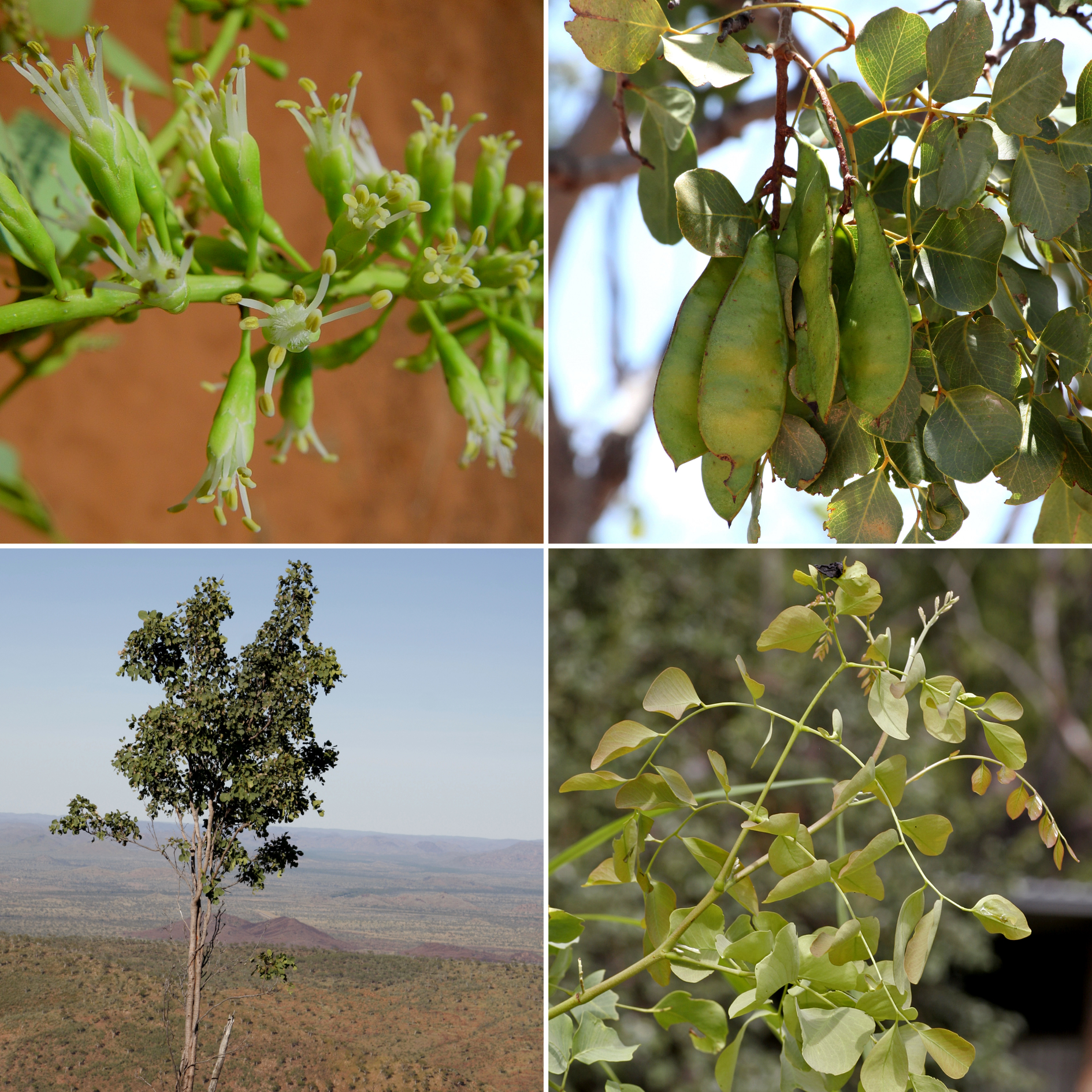 Clockwise from top left: Flowers of Erythrophleum arenarium, pods of E. pubescens (photos by Geoff Byrne), leaves of E. pubescens and habit of E. chlorostachys (photos by Russell Barrett).
Clockwise from top left: Flowers of Erythrophleum arenarium, pods of E. pubescens (photos by Geoff Byrne), leaves of E. pubescens and habit of E. chlorostachys (photos by Russell Barrett).
Barrett, R.L. & Barrett, M.D. 2023. Taxonomic revision of Australian Erythrophleum (Fabaceae: Caesalpinioideae) including description of two new species. Australian Systematic Botany 36(5): 401-426.
Baphia arenicola: a new geoxyle from Kalahari sand savannas in central Angola
The c. 50 species of the genus Baphia across tropical Africa are almost all shrubs or small trees of woodlands, forests and savannas. However, B. arenicola, recently described by Goyder et al. (2023) from the Kalahari sand savannas of central Angola, is quite different. This unusual species is a geoxylic suffrutex forming large mats arising from extensive woody below-ground stems which comprise considerable underground woody biomass. Species of geoxyle habit, characterised by Frank White as forming the underground forests of Africa, are generally considered adaptations to fire and / or frost. The grasslands where B. arenicola occurs are rich in geoxyles and are found on fossil river terraces of white, highly leached sands, largely devoid of nutrients. Like other species of Baphia, this new species also has unifoliolate leaves.
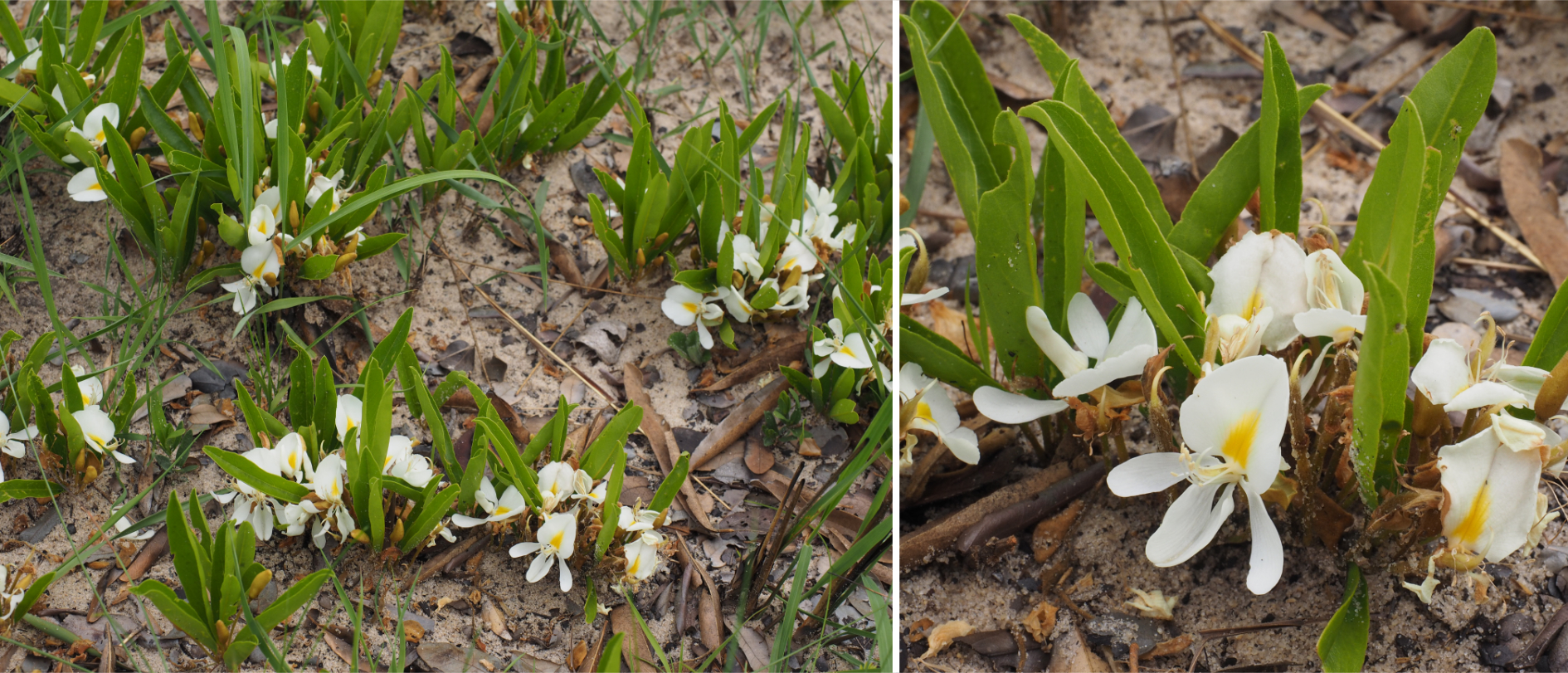 Baphia arenicola flowering at ground level on short prostrate shoots and forming extensive colonies arising from large underground woody stems, a classical geoxyle suffrutex habit, growing on heavily leached, nutrient-poor white sands in central Angola. Photos: David Goyder.
Baphia arenicola flowering at ground level on short prostrate shoots and forming extensive colonies arising from large underground woody stems, a classical geoxyle suffrutex habit, growing on heavily leached, nutrient-poor white sands in central Angola. Photos: David Goyder.
Goyder, D.J., Davies, N., Finckh, M., Gomes, A., Gonçalves, F.M.P., Meller, P. & Paton, A.J. 2023. New species of Asclepias (Apocynaceae), Baphia (Leguminosae), Cochlospermum (Bixaceae) and Endostemon (Lamiaceae) from the Kalahari sands of Angola and NW Zambia, with one new combination in Vangueria (Rubiaceae). PhytoKeys 232: 145-166.
Androcalymma rediscovered after 86 years
The rediscovery of the long-lost and very poorly understood genus Androcalymma (subfamily Dialioideae) reported in a paper by Falcão et al. published in 2023 is one of the highlights of the legume year. Androcalymma glabrifolium is the only species in its genus. First collected by Krukoff in Brazilian Amazon in 1936, the genus was described by Dwyer in 1958 based on its unusual hood-shaped anthers. Known only from the type and one other collection, from close to the indigenous village of Belém do Solimões, of the Ticuna people in the heart of the Amazon close to the border between Brazil, Colombia, and Peru, it was not seen again for 86 years. In 2022 the species (and genus) was rediscovered during an expedition by Falcão et al. to an area of indigenous lands on the Solimões River.
Until this rediscovery, the genus had remained poorly-known and was even considered to possibly be extinct. This rediscovery allowed new collections and field observations to be made and photographs to be obtained. Now the fruits of this large 30-40m tall tree of primary terra firme forests have been described for the first time, together with the shape and colour of its flowers. These new field collections also provided DNA for sequencing, enabling Androcalymma to be included in the Dialioideae phylogeny for the first time, and revealing it to be sister to the genus Dicorynia, which is also from Amazonia. As currently known Androcalymma is extremely narrowly restricted geographically, from an area of just 8km2, and was assigned an IUCN Threat Category of Critically Endangered. The paper by Falcão et al. presents a beautifully detailed portrait of the ecology, distribution, morphology and phylogenetic relationships of this long-lost genus of legumes.
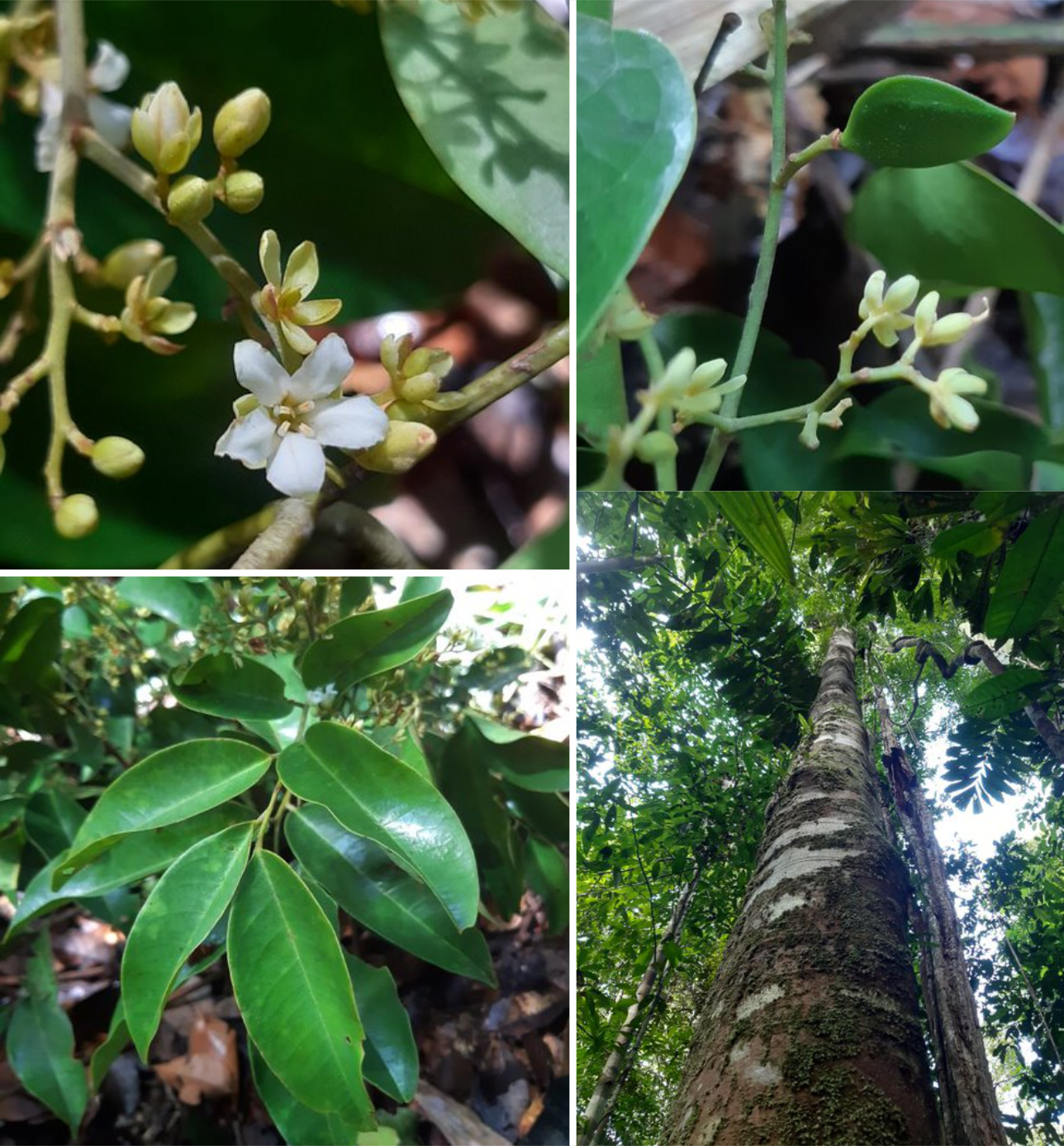 Clockwise from top left: Flowers, unripe fruit, trunk and leaf of Androcalymma glabrifolium, Photos by Marcus José de Azevedo Falcão.
Clockwise from top left: Flowers, unripe fruit, trunk and leaf of Androcalymma glabrifolium, Photos by Marcus José de Azevedo Falcão.
Falcão, M. J. A., Da Silva, G. S., & Cardoso, L. & Mansano, V. F. 2023. Unravelling the enigma of Androcalymma (Fabaceae: Dialioideae): the rediscovery of a critically endangered legume genus in the heart of the Amazon. Phytotaxa 601(2): 137-156.
18 new Indigofera species from southern Africa
The majority of new legume species being described in the modern era belong to species-rich genera and are narrowly restricted endemics, two trends that make sense as the inventory of species progresses. The genus Indigofera, with c.750 species globally, epitomises these trends with a steady on-going stream of new species being described, many of which are geographically restricted. Based on extensive field and herbarium work a suite of papers describing new South African Indigoferas have been published during 2023. Nine new species of Indigofera from the Greater Cape Floristic Region were described by Du Preez et al. (2023a,b); another nine new species from the Pondoland region of southern Africa were added by Grieve et al. (2023, 2024). All of these new species are extensively illustrated, including an abundance of photos; detailed distribution maps are presented. These increments bring the tally of species of Indigofera from the Greater Cape Floristic Region to around 100, 86 of which belong to a single ‘Cape Clade’. They also attest to the unusual ecological amplitude of the genus spanning almost every seasonally dry habitat across southern Africa. These novelties reflect the diversity of life histories of the genus in that region: I. barkeri is a dwarf annual herb, 5-20 cm tall, with trifoliolate leaves, I. pondoensis is an erect muti-stemmed suffrutex, I. tanquana is a thick-stemmed shrub with spinescent branches, and I. vanwykii is an erect woody shrub to 2 m ht. Grieve et al. suggest that 80 to 90 species of Indigofera from South Africa still remain to be described.
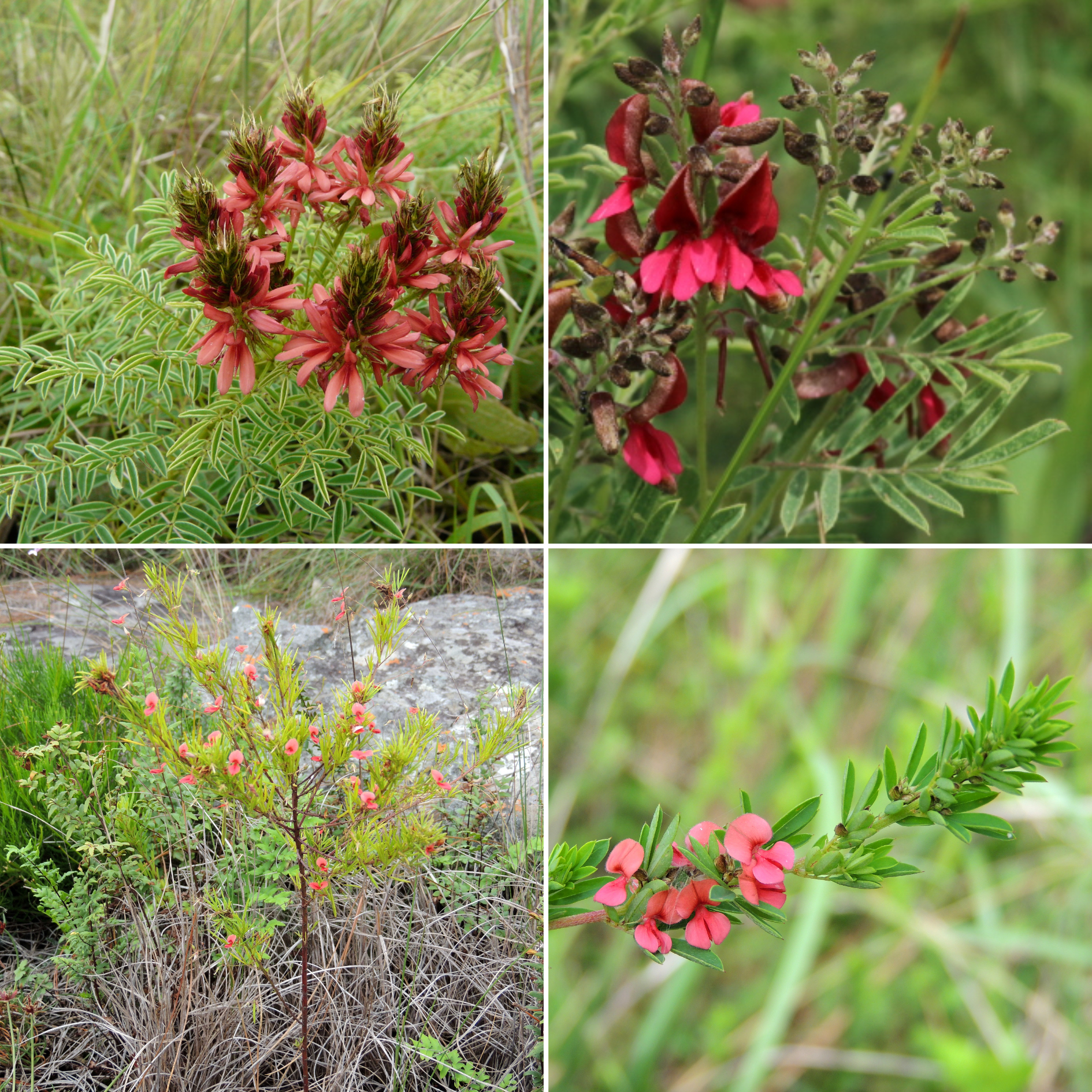 A selection of new species of Indigofera from 2023. Clockwise from top left: Indigofera hydra (photo by A.T.D. Abbott); I. gerrardiana, I. tysonii, I. herrstreyi var. herrstreyi (photos by Graham Grieve).
A selection of new species of Indigofera from 2023. Clockwise from top left: Indigofera hydra (photo by A.T.D. Abbott); I. gerrardiana, I. tysonii, I. herrstreyi var. herrstreyi (photos by Graham Grieve).
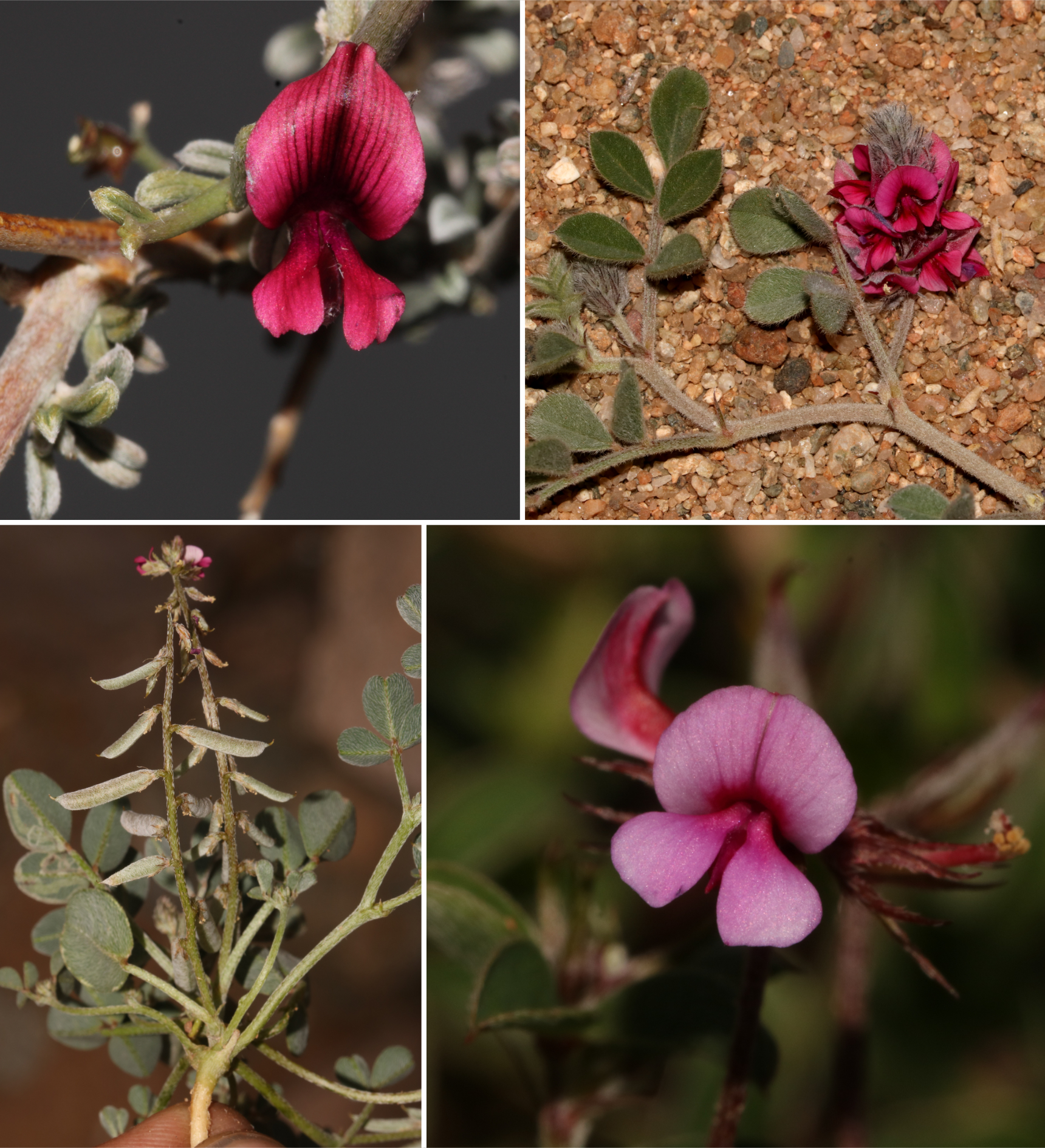 Clockwise from top left: Indigofera tanquana, I. gariepensis, I. dodii and I. barkeri (photos by Brian du Preez).
Clockwise from top left: Indigofera tanquana, I. gariepensis, I. dodii and I. barkeri (photos by Brian du Preez).
Du Preez, B., Schrire, B.D., Dreyer, L.L., Stirton, C.H., Chimphango, S.B.M. & Muasya, A.M. 2023a. Revision of Indigofera section Oligophyllae (Fabaceae: Indigofereae) from South Africa. South African Journal of Botany 159: 544-562.
Du Preez, B., Schrire, B.D., Dreyer, L.L., Stirton, C.H., Chimphango, S.B.M. & Muasya, A.M. 2023b. Four new Indigofera (Fabaceae: Indigofereae) species from the Greater Cape Floristic Region. South African Journal of Botany 162: 680-687.
Grieve, K.W., Grieve, G.R. & Schrire, B.D. 2023. New and poorly known taxa of Indigofera (Fabaceae, Papilionoideae, Indigoferae) from the Pondoland Centre of Endemism, South Africa: Part 1. South African Journal of Botany 160: 55-74.
Grieve, K.W., Grieve, G.R. & Schrire, B.D. 2024 (available online, 2023). New and poorly known taxa of Indigofera (Fabaceae, Papilionoideae, Indigofereae) from the Pondoland Centre of Endemism, South Africa: Part 2. South African Journal of Botany 164: 297-321.
Flying-buttressed Monopteryx trees in Amazonia
As part of a detailed and amply illustrated taxonomic account of the small Amazonian tree genus Monopteryx by Carvalho et al. (2023), the species M. inpae W.A.Rodrigues ex C.S.Carvalho, H.C.Lima & D.B.O.S.Cardoso is newly described to occupy the place of M. inpae W.A.Rodrigues, a name misapplied and not validly published. Even though this species does not represent a brand-new species discovery, it is highlighted here in the Bean Bag as a very interesting, unusual, and poorly known legume genus of giant rainforest trees. First, Monopteryx trees have unusual flattened, board-like, much-branched, flying buttresses which form arches from the elevated base of the trunk to the ground, which are unique among Amazonian buttressed leguminous trees. Second, Monopteryx species have unusual bilaterally symmetrical but not truly papilionate flowers.
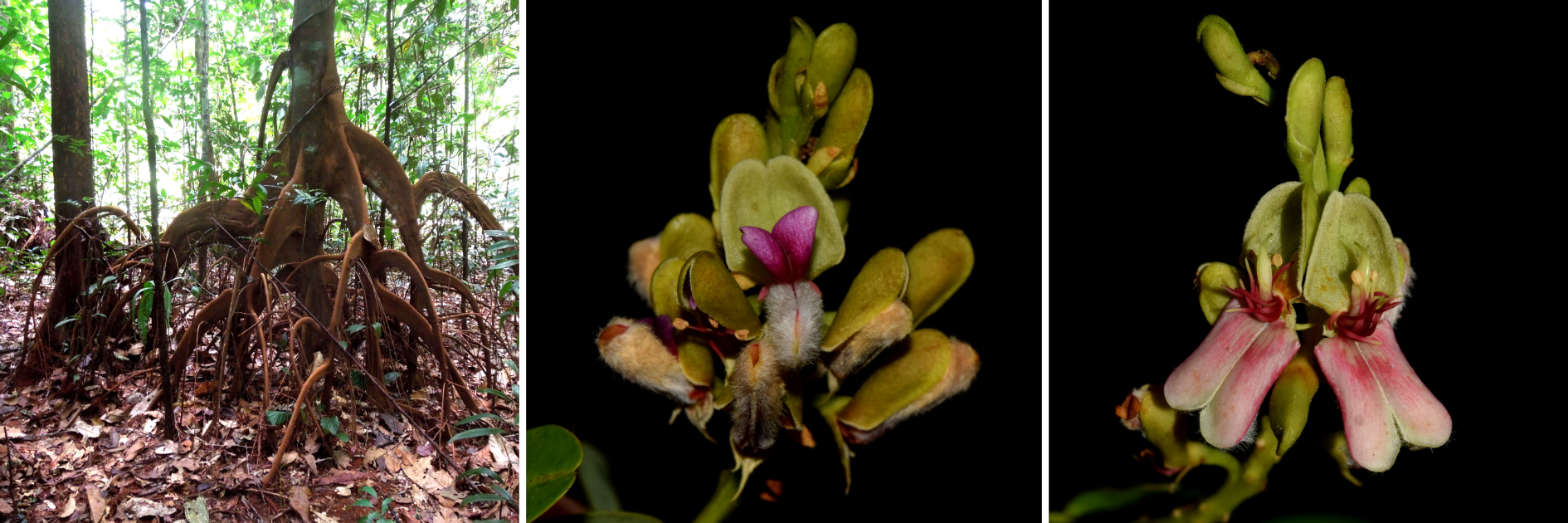 Left: Flying buttressed tree of Monopteryx uaucu (photo by Domingos Cardoso); centre and right: Flowers of Monopteryx inpae (photos by Francisco Farroñay). Centre: a flower before pollination when the densely hairy keel petals conceal the wing petals and fully enclose the androecium and gynoecium; Right: a flower post-pollination where the keel is fully open exposing the reproductive structures.
Left: Flying buttressed tree of Monopteryx uaucu (photo by Domingos Cardoso); centre and right: Flowers of Monopteryx inpae (photos by Francisco Farroñay). Centre: a flower before pollination when the densely hairy keel petals conceal the wing petals and fully enclose the androecium and gynoecium; Right: a flower post-pollination where the keel is fully open exposing the reproductive structures.
Carvalho, C.S., de Lima, H.C., Zartman, C.E. & Cardoso, D.B. 2023. A taxonomic revision of Monopteryx (Leguminosae): A florally divergent and ancient papilionoid genus of large Amazonian trees. Systematic Botany 48(3): 447-468.
Nine new tree species of Dalbergia from Madagascar
The on-going large-scale description of new species of Dalbergia from Madagascar, which we reported on in last year’s Bean Bag, represents a fascinating story in modern plant systematics. This Madagascan Dalbergia inventory initiative benefits from a very densely sampled phylogeny which is based on sequencing > 2000 nuclear genes for 683 accessions of Dalbergia from Madagascar, alongside morphological assessment of > 5,000 field collections, i.e., it is one of the most thorough attempts to combine large scale molecular data with morphology for species delimitation for any legume group undertaken to date. Forty-three species of Dalbergia were recognised in the Legumes of Madagascar book published in 2002. Twenty years later the tally of Dalbergia species for Madagascar is up to 64, including eight species newly described this year by Wilding et al. (2023) and one by Rakotonirina et al. (2023). All nine of these new species form trees large enough to have commercial potential for exploitation of their highly-prized and valuable hardwood, the rosewoods. Eight of these new species are judged to be threatened. Seven more new species of Dalbergia from Madagascar are in the pipeline. Completing the species inventory for Dalbergia is especially important given the massive increase in illegal and unsustainable exploitation of precious woods which prompted CITES (the Convention on International Trade in Endangered Species of Wild Fauna and Flora) to place Malagasy species of Dalbergia on its Appendix II in 2013, resulting in a total embargo on international trade. Any future exploitation of rosewoods needs to be based on an accurate inventory of species, where they grow, how threatened they are, and how they can be identified, and the Madagascar Dalbergia inventory is making impressive strides towards achieving that.
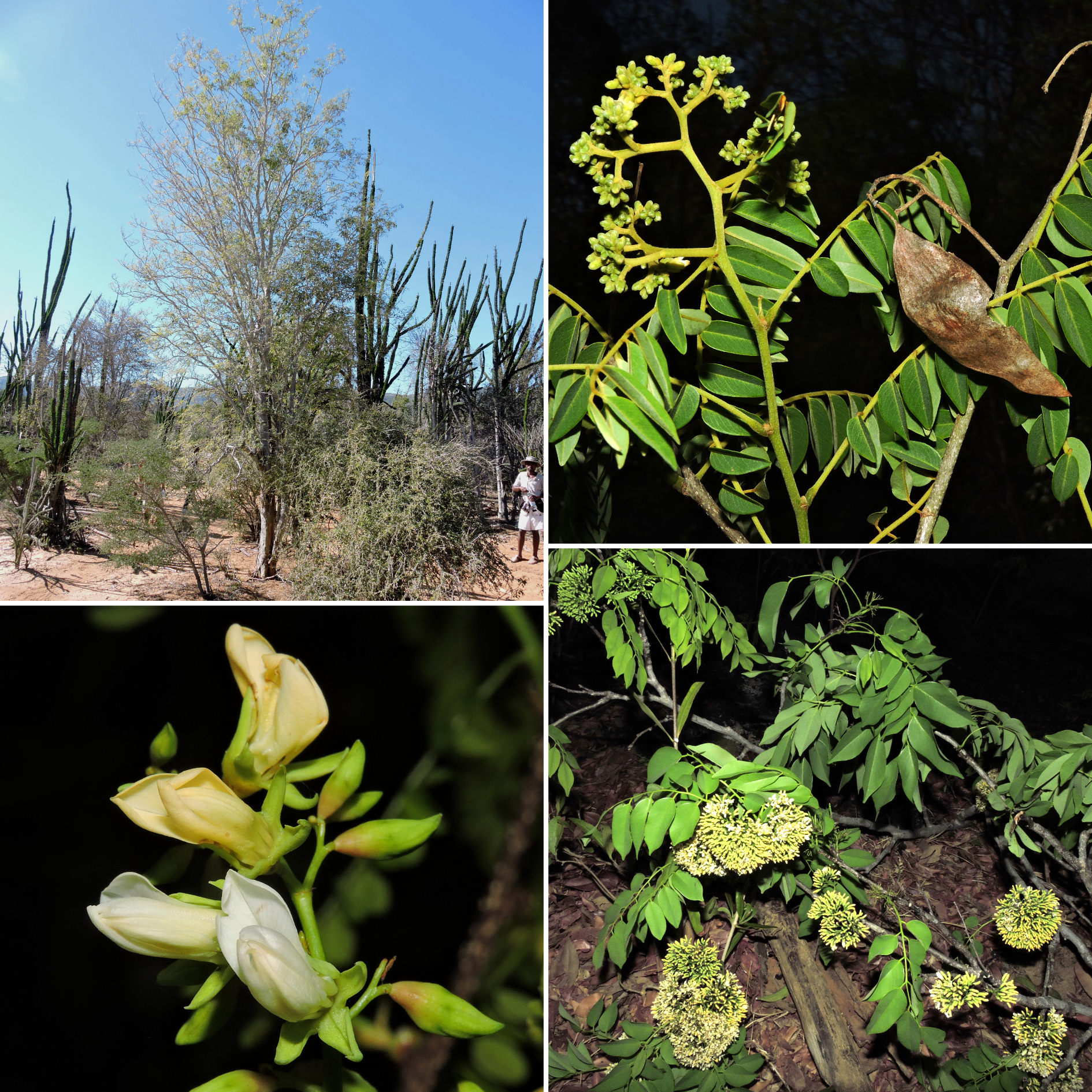 Clockwise from top left: Dalbergia nemoralis in semi-arid S Madagascar with Didierea procera, and shrubby Grewia and Mimosa spp. (photo by R. Andriamiarisoa); D. rakotovaoi in W Madagascar (photo by S. Andrianarivelo); D. rajeri, N Madagascar showing the remarkably large and dense inflorescences of this species (photo by R. Randrianaivo); D. pseudomaritima in humid SE Madagascar (photo by S. Andrianarivelo).
Clockwise from top left: Dalbergia nemoralis in semi-arid S Madagascar with Didierea procera, and shrubby Grewia and Mimosa spp. (photo by R. Andriamiarisoa); D. rakotovaoi in W Madagascar (photo by S. Andrianarivelo); D. rajeri, N Madagascar showing the remarkably large and dense inflorescences of this species (photo by R. Randrianaivo); D. pseudomaritima in humid SE Madagascar (photo by S. Andrianarivelo).
Rakotonirina, N., Phillipson, P.B., Crameri, S., Wilding, N., Lowry II, P.P., Rakouth, B. & Razakamalala, R. 2023. Taxonomic studies on Malagasy Dalbergia (Fabaceae). IV. A new species from central and southern Madagascar and a narrowed circumscription for D. emirnensis. Novon 31(1): 73-87.
Wilding, N., Phillipson, P.B. & Crameri, S. 2023. Taxonomic studies on Malagasy Dalbergia (Fabaceae). V. Eight new large tree species and notes on related Malagasy species. Candollea 78(2): 99-126.
Macrolobium paulobocae
Macrolobium is the second most species-rich genus in subfamily Detarioideae, with c. 75 species, most of which are distributed in the Amazon. The genus is ecologically important; some species growing as hyper-dominants and most species grow mainly on oligotrophic soils of white-sand vegetation, and seasonally inundated black-water floodplain forests known as igapó, including the species newly described by Farroñay et al. (2023), M. paulobocae. The species was named in honour of the Brazilian botanist Paulo Apóstolo Costa Lima Assunção (1956–2021), better known in the botanical world as “Paulo Boca”, an expert of the Amazonia flora. Macrolobium paulobocae is known from just eight collections, from the Urubú, Marmelos, and Manicoré tributaries of the Amazon and was considered Endangered by the authors.
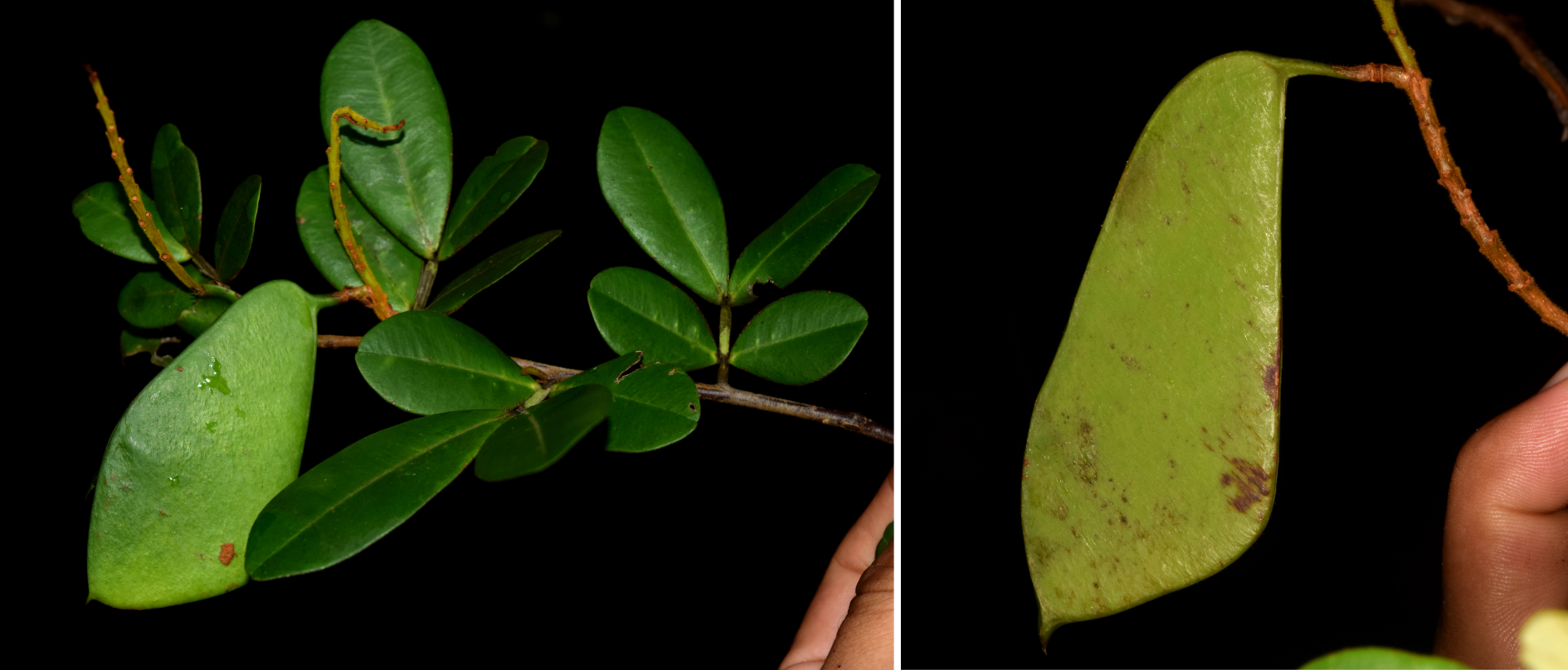 Leaves and fruit of Macrolobium paulobocae (photos by Francisco Farroñay).
Leaves and fruit of Macrolobium paulobocae (photos by Francisco Farroñay).
Farroñay, F., de Sousa Macedo, M.T., Cardoso, D. & Vicentini, A. 2023. Macrolobium paulobocae (Leguminosae, Detarioideae), a new species from seasonally inundated black-water floodplain forests in the Brazilian Amazon. Brittonia 75: 180-190.
Three new and globally rare species of Millettia
It is to be expected that the majority of plant species remaining to be described are likely to be globally rare, simply because most of the common species have already been discovered. This means that many newly described species are categorised as threatened at the time of description. This is very much the case for three new species of the genus Millettia from south-east Asia described by Mattapha et al. (2023). Each of these three species is known from just a single locality, two in Thailand and one from Vietnam. One of these is categorised as Critically Endangered, a second is likely to be so, and the third lacks sufficient data to assign an IUCN threat category at this time. Even as these new species are added, the genus Millettia remains in need of major taxonomic revision and is almost certainly polyphyletic.
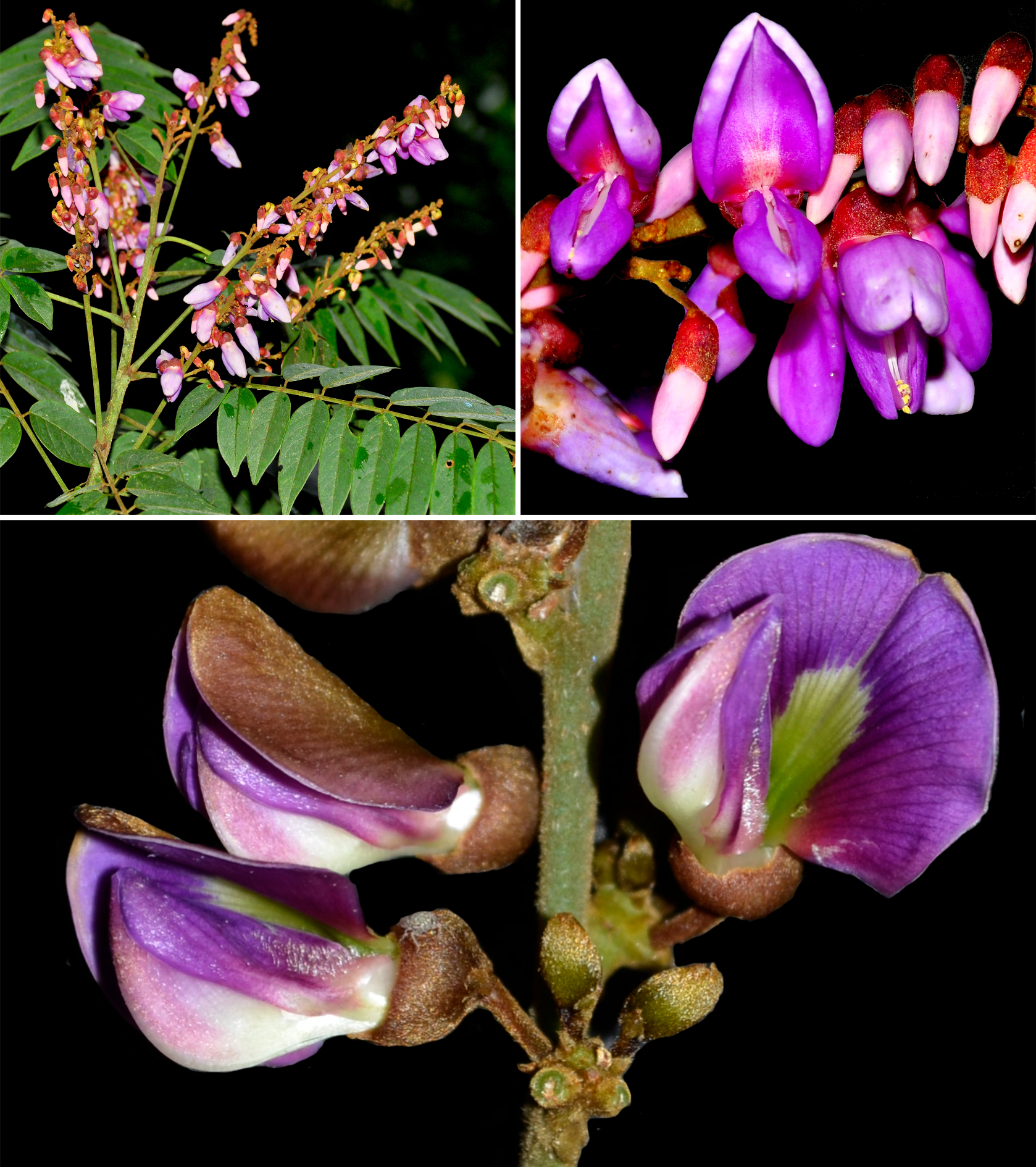 Flowers of new Millettia spp. Clockwise from top left: Inflorescence of M. calcicola (photo by C. Leeratiwong), flowers of M. calcicola (photo by C. Leeratiwong), flowers of M. khaoyaiensis (photo by Sawai Mattapha).
Flowers of new Millettia spp. Clockwise from top left: Inflorescence of M. calcicola (photo by C. Leeratiwong), flowers of M. calcicola (photo by C. Leeratiwong), flowers of M. khaoyaiensis (photo by Sawai Mattapha).
Mattapha, S., Forest, F., Schrire, B.D., Lewis, G.P., Hawkins, J. & Suddee, S. 2023. Three new species of Millettia (Leguminosae-Papilionoideae: Millettieae) from the Indo-Chinese region. Kew Bulletin 78: 175-187.
Acacia: the census continues
The genus Acacia is Australia’s most species-rich genus and, after Astragalus, the second-most species-rich genus of legumes. Just as for other large legume genera such as Indigofera (see above), or Mimosa, new species of Acacia continue to be described at a steady rate, most of them very narrowly restricted endemics. In western Australia, an important centre of species diversity for the genus, 390 species of Acacia have been described in the last 50 years, many as a result of intensive taxonomic work in the region by Bruce Maslin, but there are still on-going increments. Indeed, Thiele et al. (2023) suggest that around 75 informally-named and incompletely-known species remain to be dealt with from this region. Acacia armigera is one such entity, first collected in 2015, and now formally named following collection of complete material. Acacia armigera is so named for its rigid finely acicular armed phyllodes which together with the dense, rigid, highly-branched crown, form formidably armed shrubs.
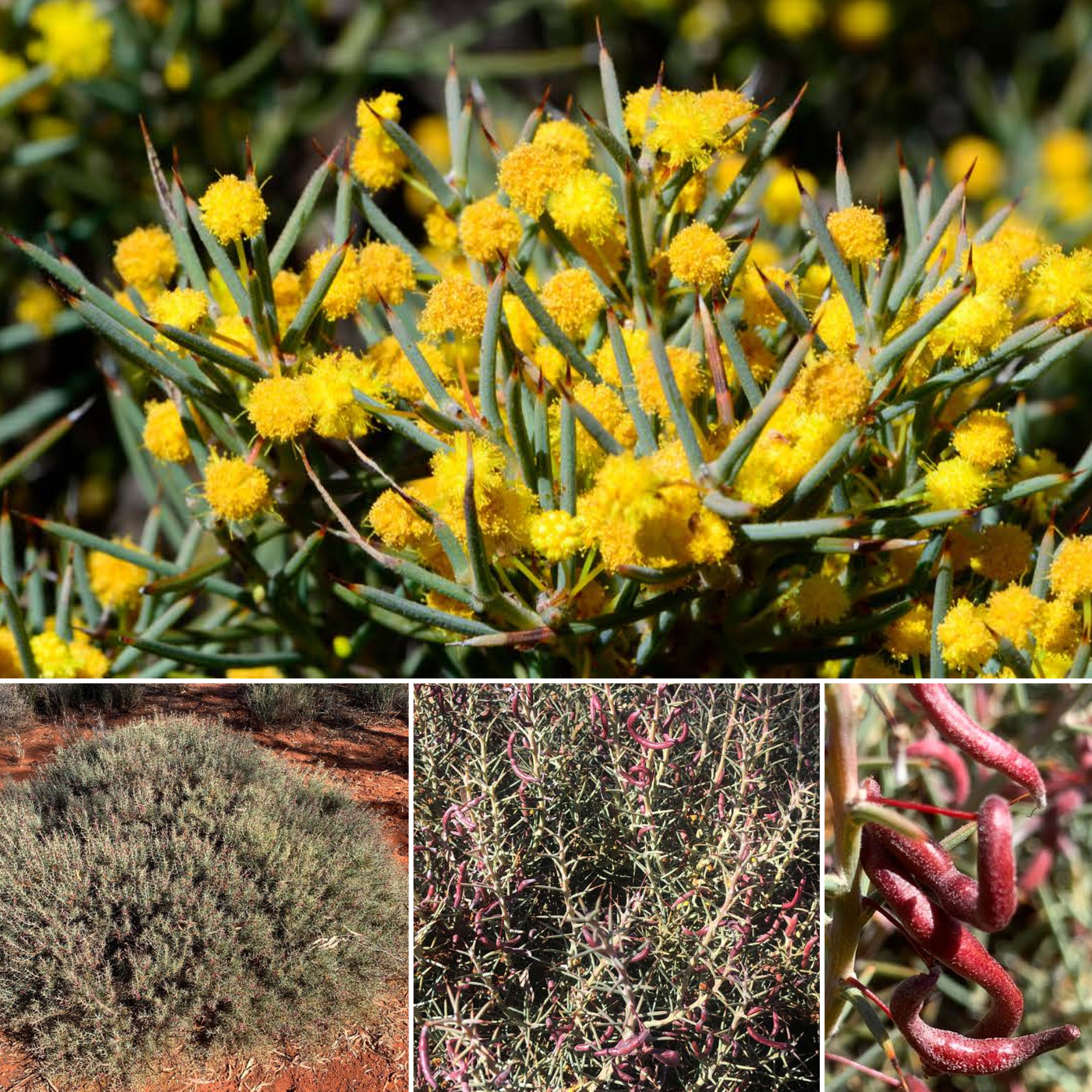 Left to right: Acacia armigera at the type locality in W Australia. Top: flowering branch (photo by K.R. Thiele); Bottom, from left to right: shrubby habit; acicular phyllodes; fruits (photos by G. Cockerton).
Left to right: Acacia armigera at the type locality in W Australia. Top: flowering branch (photo by K.R. Thiele); Bottom, from left to right: shrubby habit; acicular phyllodes; fruits (photos by G. Cockerton).
Thiele, K.R., Davis, R.W. & Cockerton, G.T., 2023. Acacia armigera (Fabaceae), a new, geographically restricted wattle from the Coolgardie bioregion of Western Australia. Nuytsia 34: 95-98.